Study on the Drag Reduction Characteristics of the Surface Morphology of Paramisgurnus dabryanus Loach
Abstract
:1. Introduction
2. Materials and Methods
2.1. Analysis of the Scale Structure of the Loach
2.2. Preparation of Samples
2.3. Flow Channel Experiments
2.3.1. Design of Test Device
2.3.2. Experiment Plan
3. Results and Analysis
3.1. Structure of the Loach Scales
3.2. Results of the Channel Test
3.3. Numerical Simulation
3.3.1. Establishment of the Model
3.3.2. Setting of Initial Conditions
3.3.3. Mesh Generation
3.3.4. Simulation Scheme
3.3.5. Results of Numerical Simulation
3.4. Comparison between Results of Numerical Simulation and Experiment
4. Mechanism Analysis
4.1. X-z Plane “Corrugated” Flow
4.2. Stable High and Low Speed Streaks and Variation Trend of Bionic Surface Velocity
4.3. The Vortex Lifting Mechanism in the x-y Plane
5. Conclusions
- (1)
- An aluminum sample was processed by the CNC method, and a flow channel was built. The sample size was 70 × 64 × 5 mm3 with hundreds of bionic fish scale units. The drag reduction rate of the sample could reach 23% when the velocity was 1.683 m/s.
- (2)
- A model with 23 scales was built for numerical simulation. A drag reduction effect was achieved within a velocity range of 0.8–11 m/s, and the maximum drag reduction rate was 7.65% when the flow velocity was 1.4 m/s.
- (3)
- The bionic micro-structure can control near-wall flow, reduce near-wall velocity gradient, increase boundary layer thickness, and delay the transition of layer flow turbulence.
- (4)
- Due to the existence of high and low pressure zones, alternating high and low speed streaks were generated in the x direction. As the water flows over the bionic surface, it slows down significantly, which could effectively reduce the Reynolds number and delay the transition of laminar to turbulent flow.
- (5)
- Vortices were generated behind each scale, which helped to form the liquid-liquid friction film and thus reducing the resistance.
Author Contributions
Funding
Institutional Review Board Statement
Informed Consent Statement
Data Availability Statement
Conflicts of Interest
References
- Sindagi, S.; Vijayakumar, R. Succinct review of MBDR/BDR technique in reducing ship’s drag. Ships Offshore Struct. 2020, 6, 968–979. [Google Scholar] [CrossRef]
- Zolotovsky, K.; Varshney, S.; Reichert, S.; Arndt, E.M.; Dao, M.; Boyce, M.C.; Ortiz, C. Fish-inspired flexible protective material systems with anisotropic bending stiffness. Commun. Mater. 2021, 35, 2. [Google Scholar]
- Guan, H.Y.; Feng, X.M.; Zhang, J.Q.; Niu, S.C.; Han, Z.W. Phragmites Communis Leaves with Anisotropy, Superhydrophobicity and Self-Cleaning Effect and Biomimetic Polydimethylsiloxane (PDMS) Replicas. Coatings 2019, 9, 541. [Google Scholar] [CrossRef] [Green Version]
- Hou, Q.M.; Yang, X.F.; Cheng, J.; Wang, S.R.; Duan, D.R.; Xiao, J.P.; Li, W.Y. Optimization of Performance Parameters and Mechanism of Bionic Texture on Friction Surface. Coatings 2020, 10, 171. [Google Scholar] [CrossRef] [Green Version]
- Zhang, S.J.; Zhang, J.Q.; Zhu, B.; Niu, S.C.; Han, Z.H.; Ren, L.Q. Progress in Bio-inspired Anti-solid Particle Erosion Materials: Learning from Nature but Going beyond Nature. Chin. J. Mech. Eng. 2020, 33, 42. [Google Scholar] [CrossRef]
- Hossein, P.; Mohammad, L.; Ali, M.; Ali, N.; Hossein, N. Fabrication of durable superhydrophobic surfaces using PDMS and beeswax for drag reduction of internal turbulent flow. Appl. Surf. Sci. 2020, 513, 145754. [Google Scholar]
- Ganesh, V.A.; Dinachali, S.S.; Nair, A.S.; Ramakrishna, S. Robust Superamphiphobic Film from Electrospun TiO Nanostructures. ACS Appl. Mater. Interfaces 2013, 5, 1527–1532. [Google Scholar] [CrossRef]
- Li, T.J.; Paliy, M.; Wang, X.L.; Kobe, B.; Lau, W.M.; Yang, J. A facile One-Step Photolithographic Method for Engineering Hierarchically Nano/Microstructured Transparent Superamphiphobic Surfaces. ACS Appl. Mater. Interfaces 2016, 28, 291–298. [Google Scholar] [CrossRef]
- Luo, Y.H.; Wang, L.G.; Green, L.; Song, K.; Wang, L.; Smith, R. Advances of drag-reducing surface technologies in turbulence based on boundary layer control. J. Hydrodyn. 2015, 27, 473–487. [Google Scholar] [CrossRef]
- Yu, C.M.; Liu, M.F.; Zhang, C.H.; Yan, H.; Zhang, M.H.; Wu, Q.S.; Liu, M.J.; Jiang, L. Bio-inspired drag reduction: From nature organisms to artificial functional surfaces. Giant 2020, 2, 100017. [Google Scholar] [CrossRef]
- Kumar, S.; Pandey, K.M.; Sharma, K.K. Advances in drag-reduction methods related with boundary layer control—A review. Mater. Proc. 2021, 45, 6694–6701. [Google Scholar]
- Ren, L.Q.; Liang, Y.H. Coupled Bionics, 1st ed.; Science Press: Beijing, China, 2012; p. 1. [Google Scholar]
- Stratakis, E.; Bonsec, J.; Heitz, J.; Siegel, J.; Tsibidis, G.D.; Skoulas, E.; Papadopoulos, A.; Mimidis, A.; Joel, A.C.; Comanns, P.; et al. Laser engineering of biomimetic surfaces. Mat. Sci. Eng. R 2020, 141, 100562. [Google Scholar] [CrossRef]
- Liu, G.J.; Yuan, Z.C.; Qiu, Z.Z.; Feng, S.W.; Xie, Y.C.; Leng, D.X.; Tian, X.J. A brief review of bio-inspired surface technology and application toward underwater drag reduction. Ocean Eng. 2020, 199, 106962–106970. [Google Scholar] [CrossRef]
- Wang, Y.H.; Zhang, Z.B.; Xu, J.K.; Yu, H.D. One-step method using laser for large-scale preparation of bionic superhydrophobic & drag-reducing fish-scale surface. Surf. Coat. Technol. 2021, 409, 126801. [Google Scholar]
- Lang, A.W.; Jones, E.W.; Afroz, F. Separation control over a grooved surface inspired by dolphin skin. Bioinspir. Biomim. 2017, 12, 026005. [Google Scholar] [CrossRef] [PubMed]
- Luo, Y.H.; Wang, X.D.; Liu, G.; Wang, J.S.; Song, W. Anisotropic Wetting and Fluidic Phenomena on Biological Texture and Hydrodynamic Experiments Testing on Different Low Viscous Resistance Surfaces. Adv. Eng. Mater. 2016, 18, 869–876. [Google Scholar] [CrossRef]
- Kim, J.H.; Shim, T.S.; Kim, S.H. Lithographic Design of Overhanging Microdisk Arrays toward Omniphobic Surfaces. Adv. Mater. 2016, 28, 291–298. [Google Scholar] [CrossRef]
- Li, L.C.; Liu, B.; Hao, H.L.; Li, L.Y.; Zeng, Z.X. Investigation of the drag reduction performance of bionic flexible coating. Phys. Fluids 2020, 32, 084103. [Google Scholar] [CrossRef]
- Graeber, G.; Kieliger, O.B.M.; Schutzius, T.M.; Poulikakos, D. 3D-Printed Surface Architecture Enhancing Superhydrophobicity and Viscous Droplet Repellency. ACS Appl. Mater. Interfaces 2018, 19, 43275–43281. [Google Scholar] [CrossRef] [PubMed] [Green Version]
- Lloyd, C.J.; Peakall, J.; Burns, A.D.; Keevil, G.M.; Dorrell, R.M.; Wignall, P.B.; Fletcher, T.M. Hydrodynamic efficiency in sharks: The combined role of riblets and denticles. Bioinspir Biomim. 2021, 16, 4. [Google Scholar] [CrossRef]
- An, Q.E.; Zhang, B.; Liu, G.C.; Yang, W.C.; Zhao, H.B.; Wang, J.S.; Wang, L. Directional droplet-actuation and fluid-resistance reduction performance on the bio-inspired shark-fin-like superhydrophobic surface. J. Taiwan Inst. Chem. E 2019, 97, 389–396. [Google Scholar] [CrossRef]
- Domel, A.G.; Domel, G.; Wwaver, J.C.; Saadat, M.; Bertoldi, K.; Lauder, G.V. Hydrodynamic properties of biomimetic shark skin: Effect of denticle size and swimming speed. Bioinspir. Biomim. 2018, 13, 056014. [Google Scholar] [CrossRef]
- Li, W.; Jessen, W.; Roggenkamp, D.; Klaas, M.; Silex, W.; Schiek, M.; Schröder, W. Turbulent drag reduction by spanwise traveling ribbed surface waves. Eur. J. Mech. B-Fluid 2015, 53, 101–112. [Google Scholar] [CrossRef]
- Koh, S.R.; Meysonnat, P.; Meinke, M.; Schröder, W. Drag Reduction via Spanwise Transversal Surface Waves at High Reynolds Numbers. Flow Turbul. Combust. 2015, 95, 169–190. [Google Scholar] [CrossRef]
- Zhang, G.Q.; Schlüter, J.; Hu, X. Parametric investigation of drag reduction formarine vessels using air-filled dimpled surfaces. Ships Offshore Struct. 2018, 13, 244–255. [Google Scholar] [CrossRef]
- Albers, M.; Meysonnat, P.S.; Fernex, D.; Semaan, R.; Noack, B.R.; Schröder, W. Drag Reduction and Energy Saving by Spanwise Traveling Transversal Surface Waves for Flat Plate Flow. Flow Turbul. Combust. 2020, 105, 125–127. [Google Scholar] [CrossRef] [Green Version]
- Chen, D.K.; Cui, X.X.; Chen, H.W. Dual-composite drag-reduction surface based on the multilayered structure and mechanical properties of tuna skin. Microsc. Res. Tech. 2021, 84, 1862–1872. [Google Scholar] [CrossRef] [PubMed]
- Liu, C.B.; Sheng, C.; Yang, H.L.; Yuan, Z. Design and optimization of bionic Janus blade in hydraulic torque converter for drag reduction. J. Bionic. Eng. 2018, 15, 160–172. [Google Scholar] [CrossRef]
- Zhou, H.G.; Liu, C.Q.; Tian, G.Z.; Feng, X.M.; Jia, C.F. Research on the drag reduction property of puffer (Takifugu flavidus) spinal nonsmooth structure surface. Microsc. Res. Tech. 2020, 83, 795–803. [Google Scholar] [CrossRef]
- Mohammadi, A.; Floryan, J.M. Numerical Analysis of Laminar-Drag-Reducing Grooves. ASME J. Fluid Eng. 2015, 137, 041201. [Google Scholar] [CrossRef]
- Rong, W.T.; Zhang, H.F.; Zhang, T.J.; Mao, Z.G.; Liu, X.W.; Song, K.G. Drag Reduction of Lubricant-Impregnated Anisotropic Slippery Surfaces Inspired by Bionic Fish Scales Micro/nano array structures. Adv. Eng. Mater. 2021, 23, 2000821. [Google Scholar] [CrossRef]
- Liu, D.M.; Tao, X.F.; Wang, Y.F.; Cai, B.; Du, M.; Zheng, Q. Rheological Behavior of Loach Surface Mucus. Acta Polym. Sin. 2010, 4, 468–473. [Google Scholar] [CrossRef]
- Bixler, G.D.; Bhushan, B. Shark skin inspired low-drag microstructured surfaces in closed channel flow. J. Colloid Interface Sci. 2013, 393, 384–396. [Google Scholar] [CrossRef]
- Muthuramalingam, M.; Puckert, D.K.; Rist, U.; Bruecker, C. Transition delay using biomimetic fish scale arrays. Sci. Rep. 2020, 10, 14534. [Google Scholar] [CrossRef]
- Muthuramalingam, M.; Villemin, L.S.; Bruecker, C. Streak formation in flow over biomimetic fish scale arrays. J. Exp. Biol. 2019, 222, 205963. [Google Scholar] [CrossRef] [PubMed] [Green Version]
- Zhu, Z.Y.; Li, J.; Peng, H.; Liu, D.R. Nature-Inspired Structures Applied in Heat Transfer Enhancement and Drag Reduction. Micromachines 2021, 12, 656. [Google Scholar] [CrossRef] [PubMed]
- Shen, Y.Z.; Tao, J.; Tao, H.J.; Chen, S.L.; Pan, L.; Wang, T. Anti-icing potential of superhydrophobic Ti6Al4V surfaces: Ice nucleation and growth. Langmuir 2015, 31, 10799–10806. [Google Scholar] [CrossRef] [PubMed]
- Liu, Z.Y.; Yin, W.; Tao, D.S.; Tian, Y. A glimpse of superb tribological designs in nature. Biotribology 2015, 1, 11–23. [Google Scholar] [CrossRef]
- Bhatia, D.; Li, G.; Lin, Y.; Sun, J.; Barrington, P.; Li, H.; Wang, J. Transition Delay and Drag Reduction using Biomimetically Inspired Surface Waves. J. Appl. Fluid Mech. 2020, 13, 1207–1222. [Google Scholar] [CrossRef]
- Li, W.F.; Roggenkamp, D.; Hecken, T.; Jessen, W.; Klaas, M.; Schröder, W. Parametric investigation of friction drag reduction in turbulent flow over a flexible wall undergoing spanwise transversal traveling waves. Exp. Therm. Fluid 2018, 59, 105. [Google Scholar] [CrossRef]

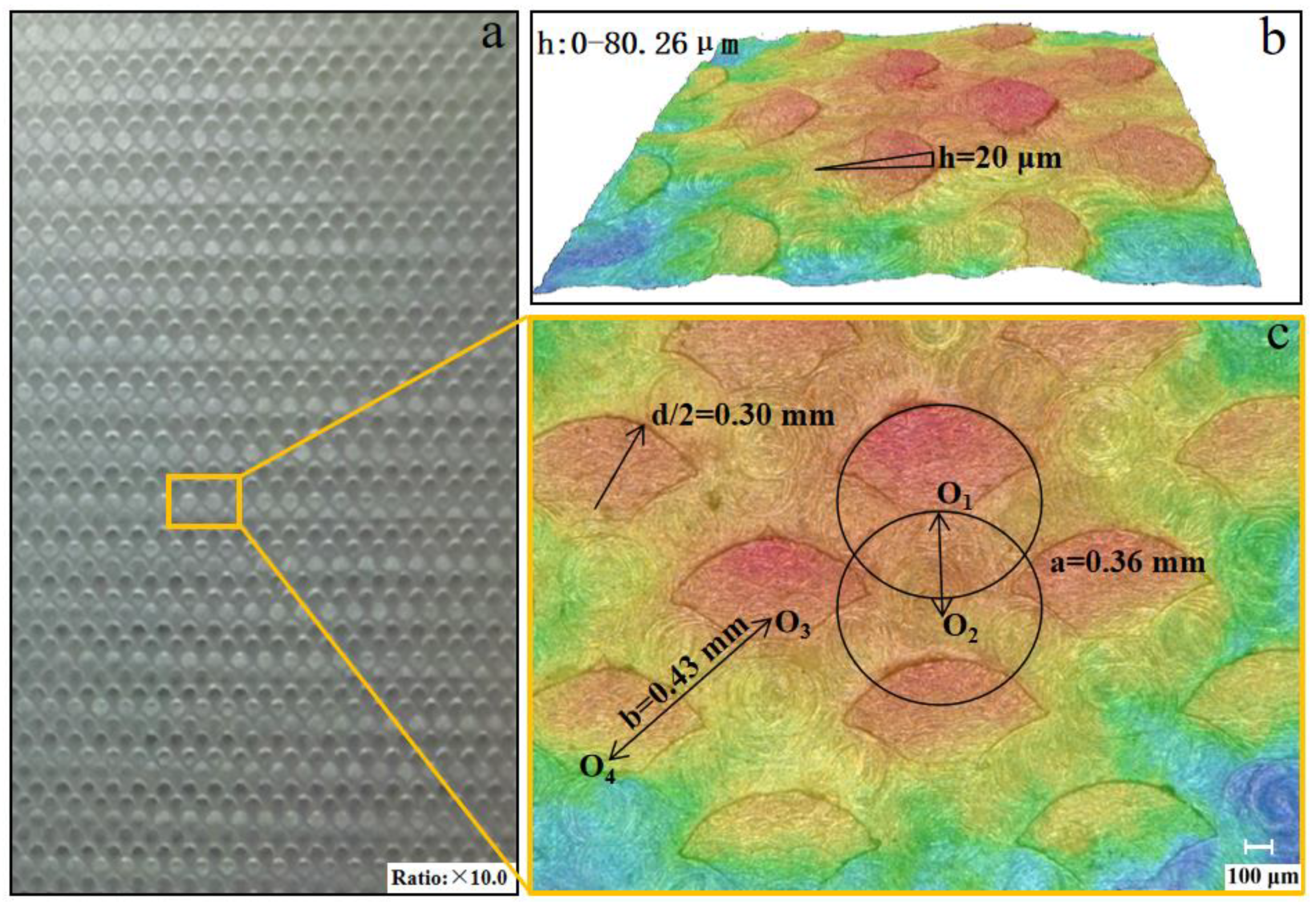

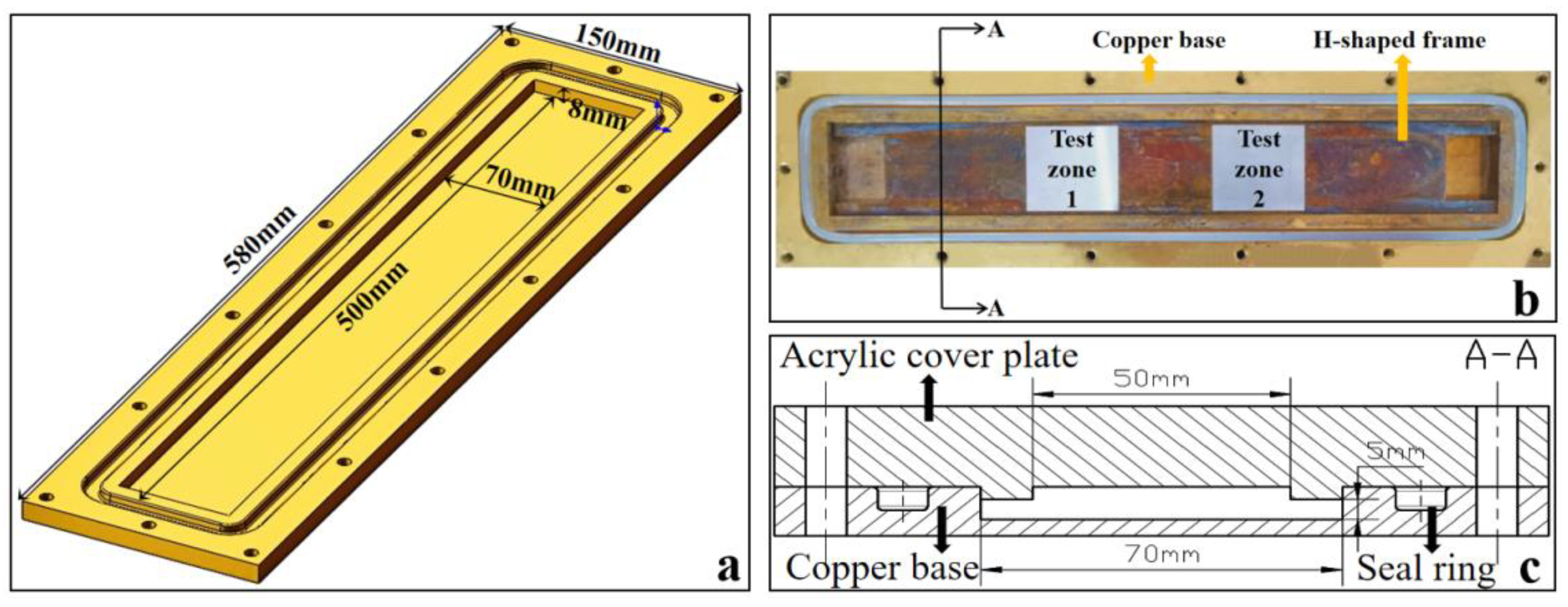

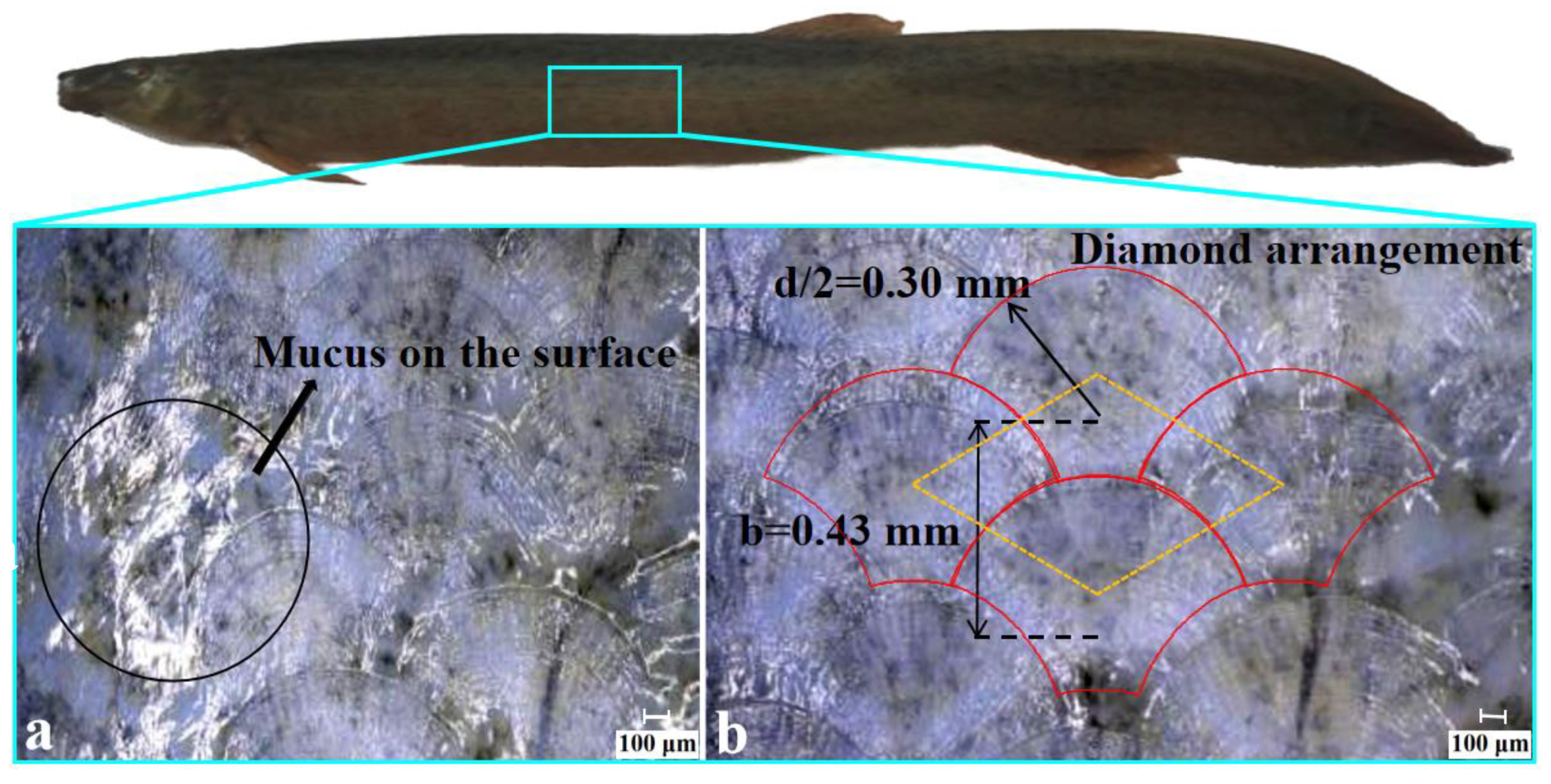



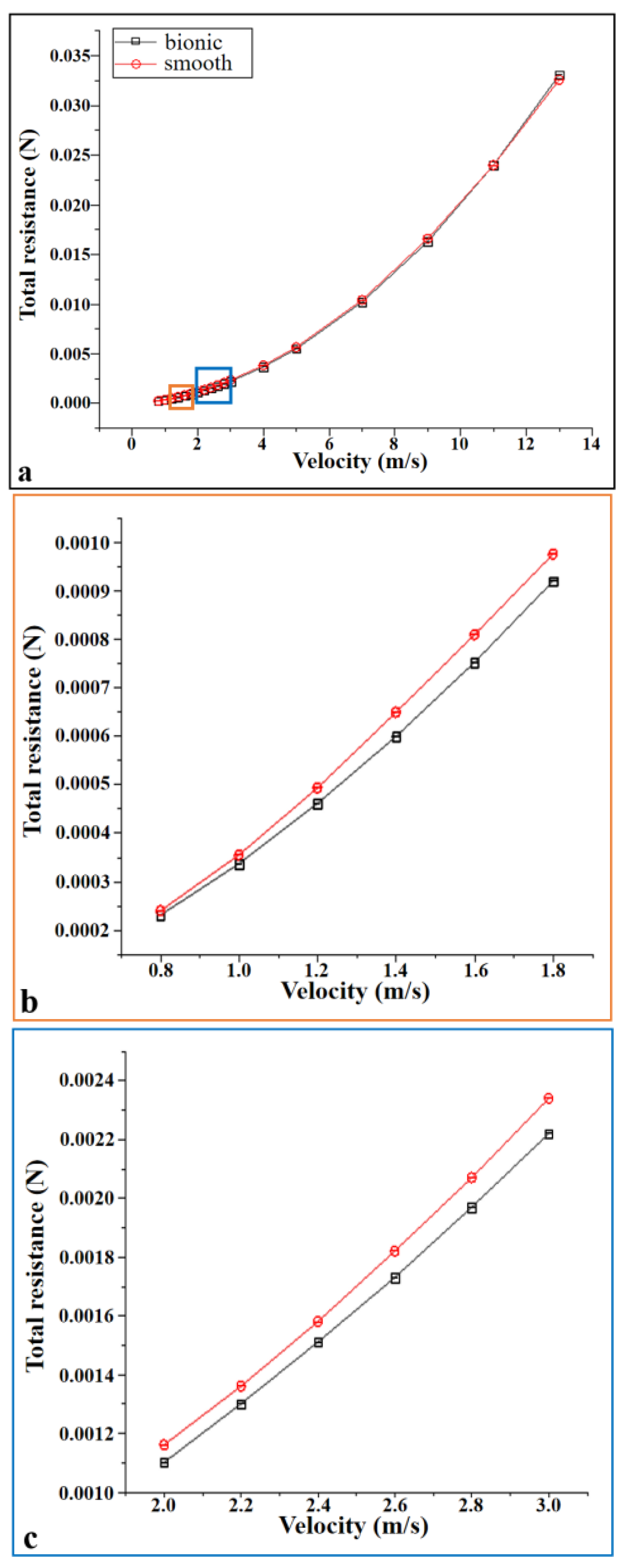
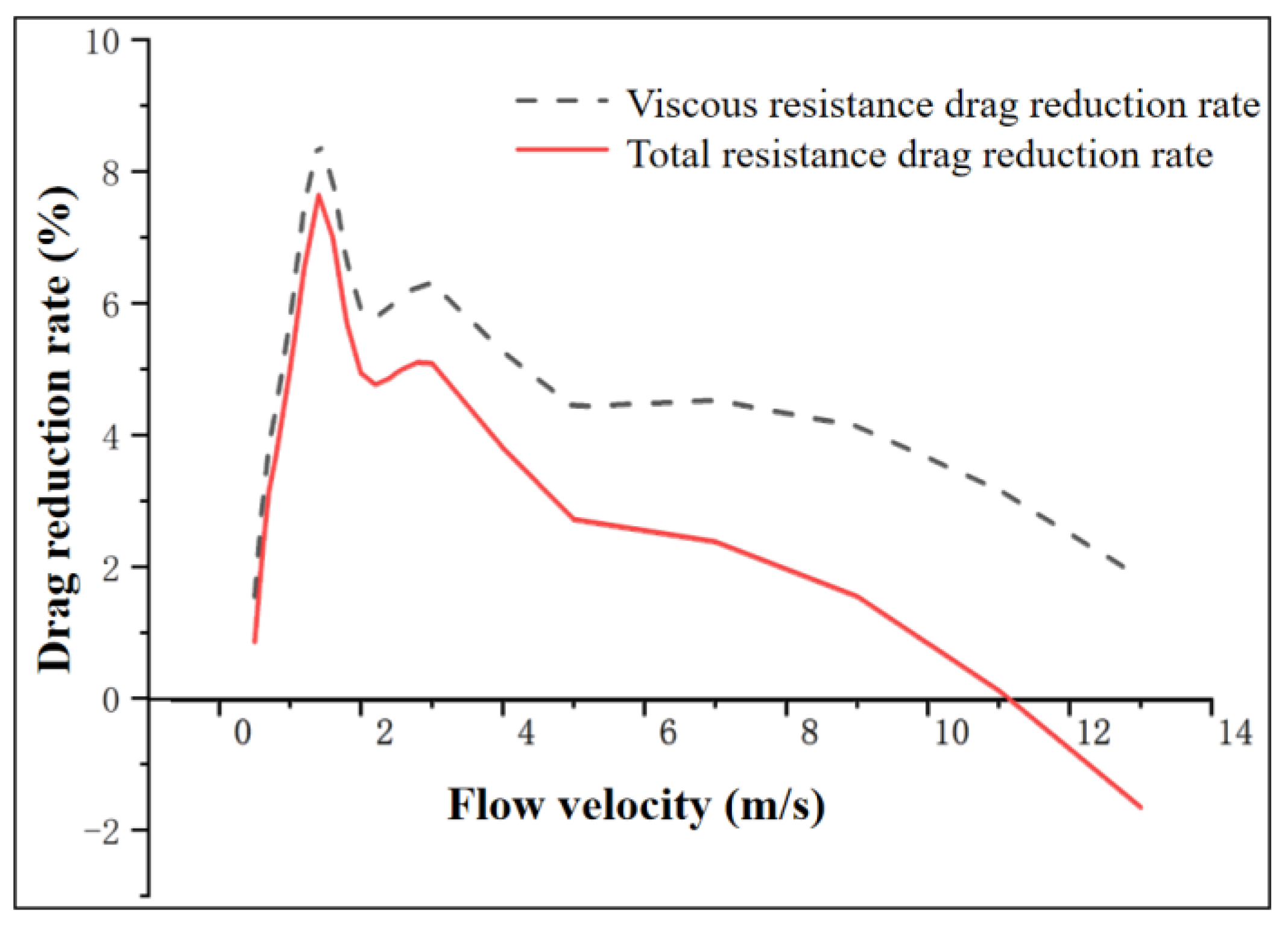

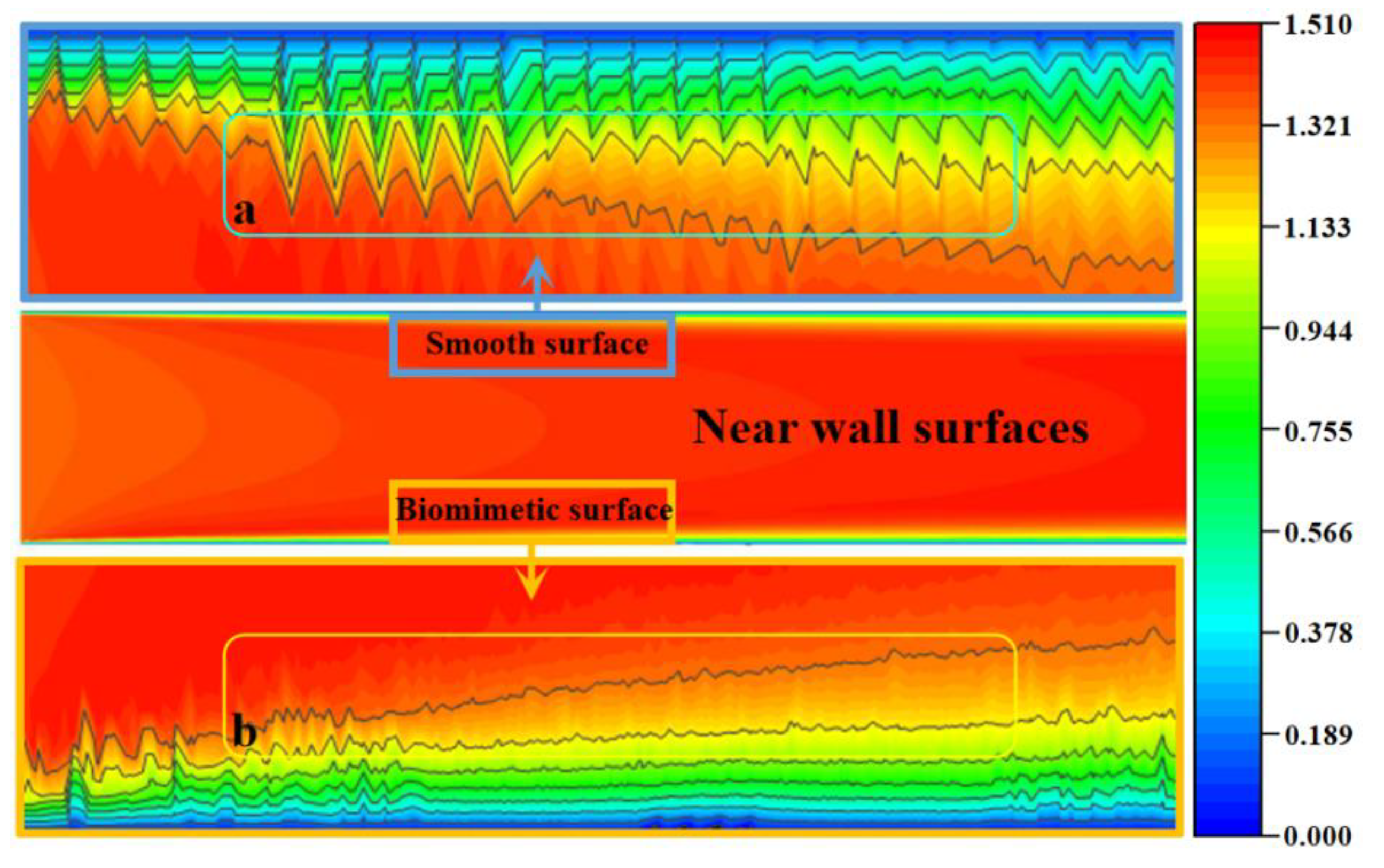



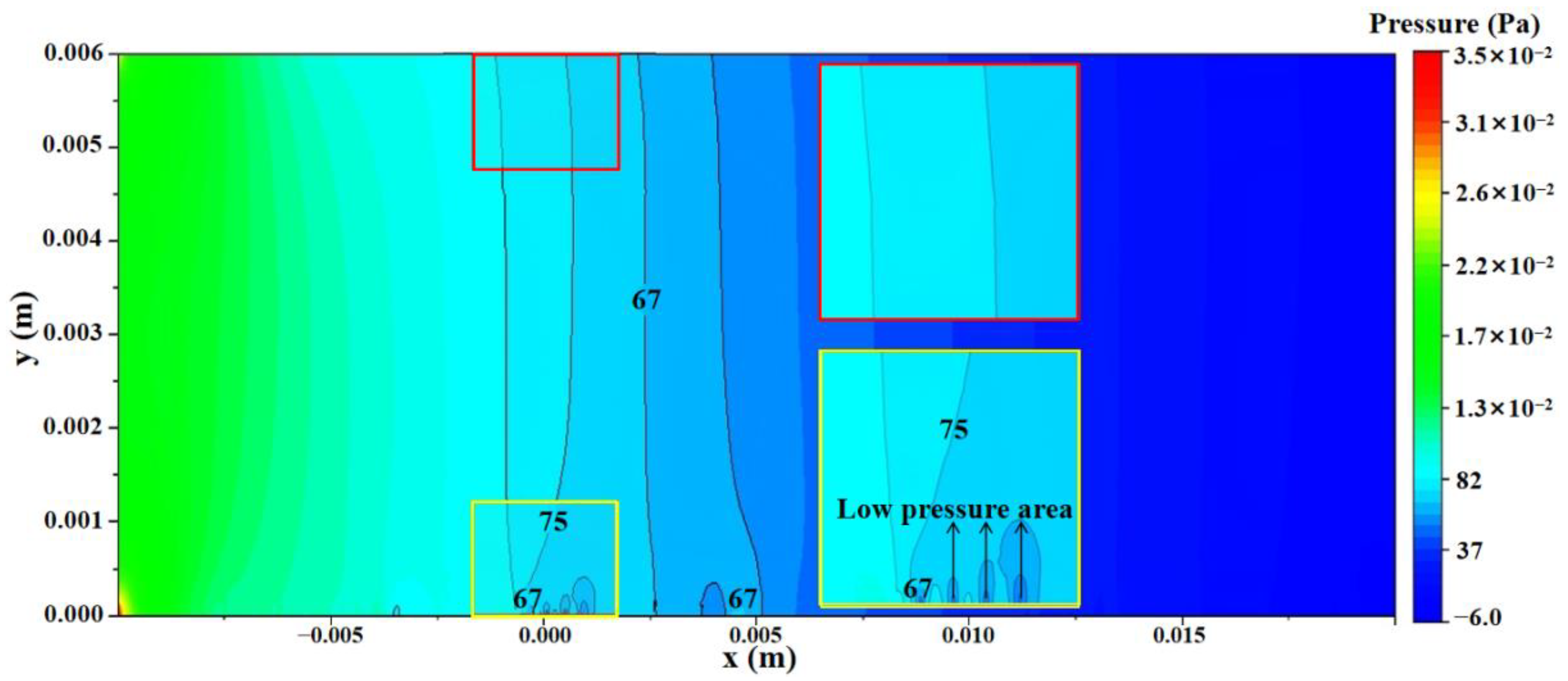



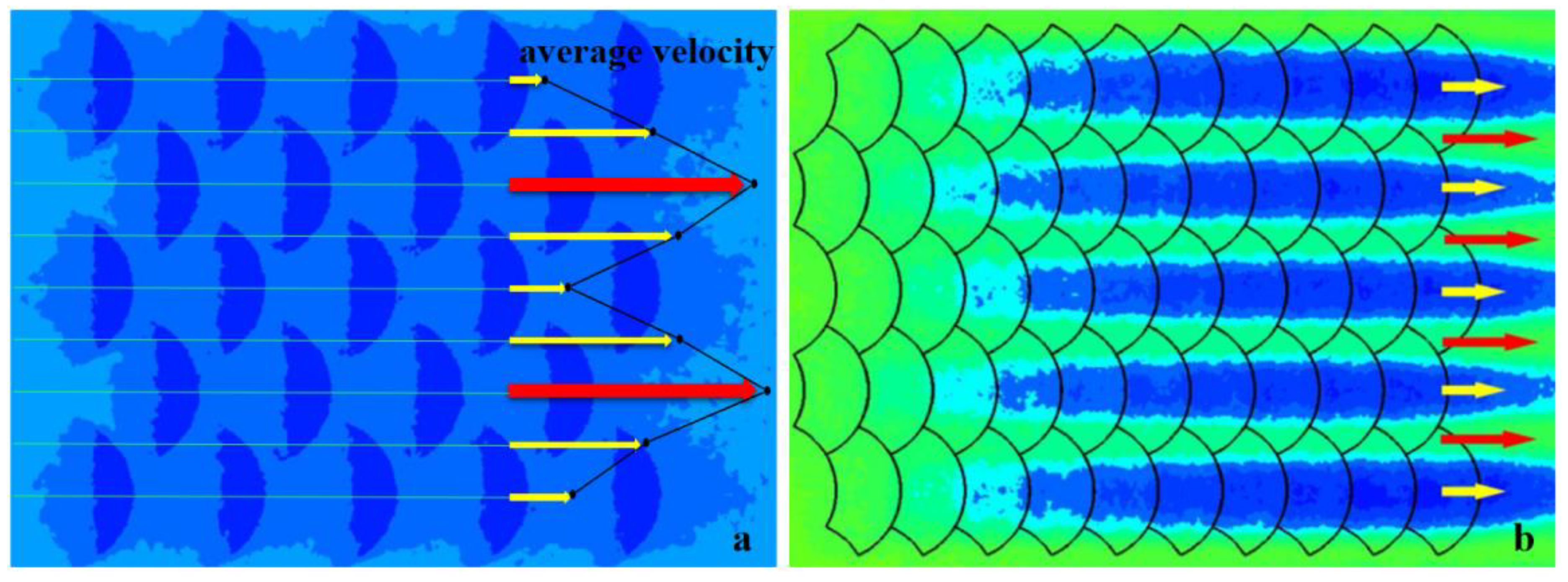
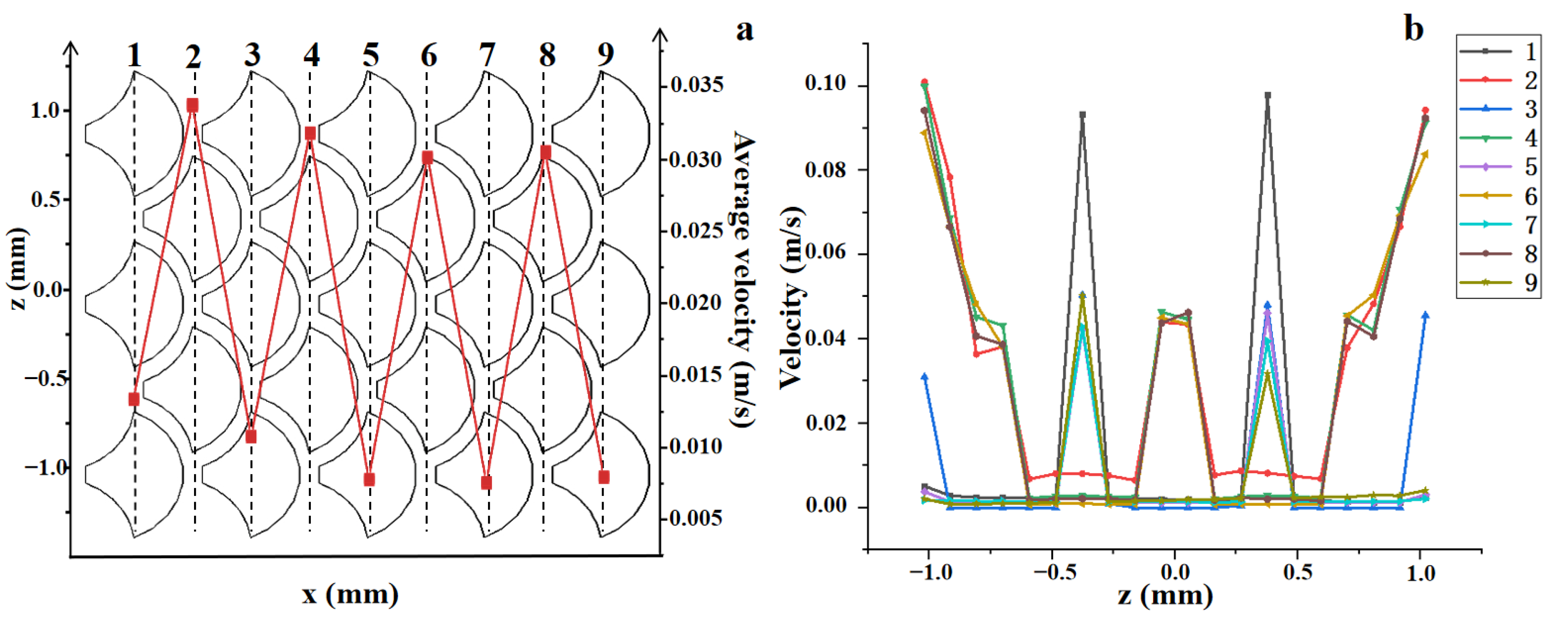
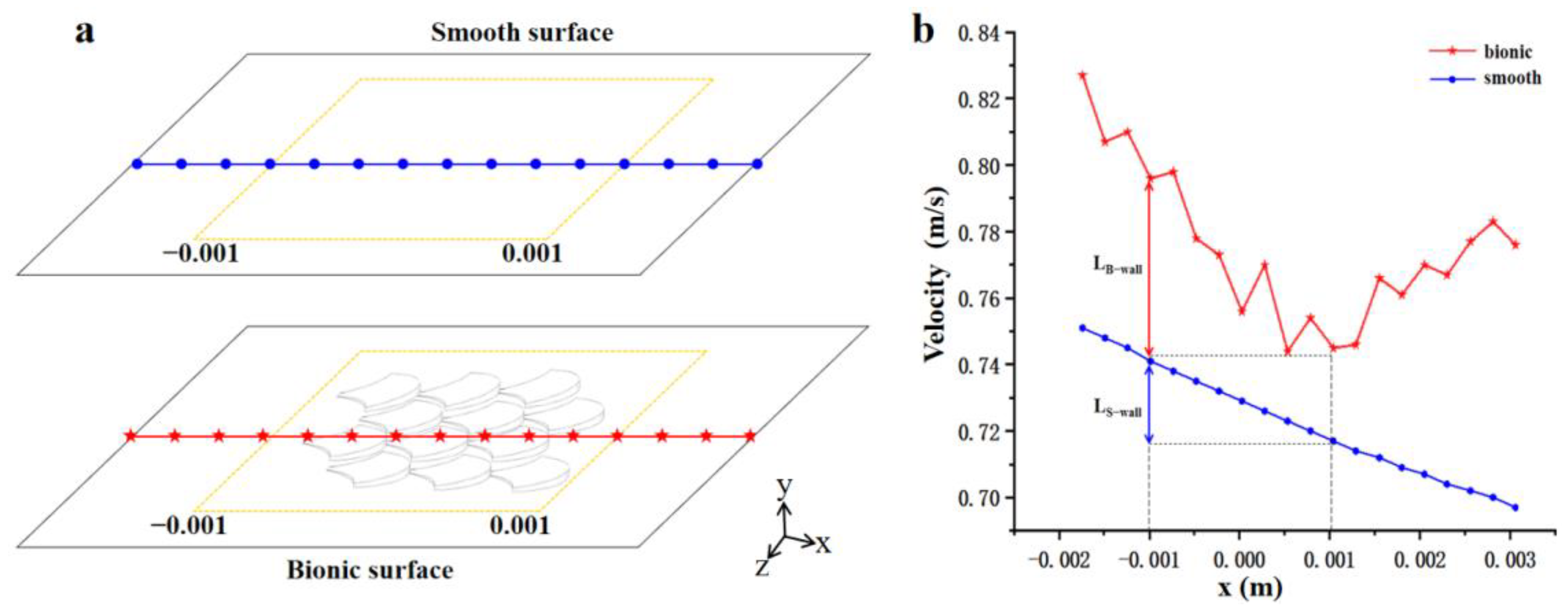

| Equipment | Type | Accuracy | Range |
|---|---|---|---|
| Pressure sensor | TXY815 | 0.5% | 0–0.6 MPa |
| Flow meter | TXY920 | Level 0.5 | 0–18 m³/h |
| DAQ card | NI9203 | 16-bit resolution 200 k/s sample frequency | - |
| Volume Flow Rate (m³/h) | PD Smooth (Pa) | SD | RSD | |||
| Smooth Test 1 | Smooth Test 2 | Smooth Test 3 | Average Value | |||
| 0.204 | 672.5468 | 683.2486 | 711.3469 | 689.0474 | 16.3622 | 2.37% |
| 0.303 | 665.9226 | 669.5486 | 703.6699 | 679.7137 | 17.0042 | 2.50% |
| 0.398 | 680.7184 | 650.3495 | 625.5408 | 652.2029 | 22.5643 | 3.46% |
| 0.507 | 646.1646 | 625.1648 | 629.6532 | 633.6608 | 9.0293 | 1.42% |
| 0.611 | 659.2171 | 665.3649 | 721.5431 | 682.0417 | 28.0442 | 4.11% |
| 0.715 | 639.2333 | 645.3654 | 702.5038 | 662.3675 | 28.4909 | 4.30% |
| 0.792 | 642.6022 | 659.2654 | 643.2336 | 648.3671 | 7.7106 | 1.19% |
| 0.900 | 636.4690 | 642.5895 | 687.5243 | 655.5276 | 22.7626 | 3.47% |
| 1.06 | 691.1193 | 746.3654 | 757.8527 | 731.7791 | 29.1308 | 3.98% |
| Volume Flow Rate(m³/h) | PD Bionic (Pa) | SD | RSD | |||
| Bionic Test 1 | Bionic Test 2 | Bionic Test 3 | Average Value | |||
| 0.204 | 628.4862 | 642.4862 | 664.9267 | 645.2997 | 15.0092 | 2.33% |
| 0.303 | 647.1653 | 689.5464 | 641.1235 | 659.2784 | 21.5444 | 3.27% |
| 0.398 | 608.2772 | 598.4687 | 560.1497 | 588.9652 | 20.7654 | 3.53% |
| 0.507 | 527.4023 | 547.6554 | 553.1338 | 542.7305 | 11.0670 | 2.04% |
| 0.611 | 560.2364 | 543.6548 | 520.4762 | 541.4558 | 16.3063 | 3.01% |
| 0.715 | 499.4779 | 489.3478 | 538.4779 | 509.1012 | 21.1801 | 4.16% |
| 0.792 | 643.6147 | 638.4715 | 707.0017 | 663.0293 | 31.1640 | 4.70% |
| 0.900 | 650.4684 | 615.2646 | 621.0669 | 628.9333 | 15.4108 | 2.45% |
| 1.06 | 710.8683 | 642.5698 | 678.2129 | 677.2170 | 27.8916 | 4.12% |
| Flow Velocity (m/s) | 0.48 | 0.713 | 0.937 | 1.193 | 1.438 | 1.683 | 1.864 | 2.118 | 2.498 |
|---|---|---|---|---|---|---|---|---|---|
| k (%) | 6% | 3% | 10% | 14% | 21% | 23% | −2% | 4% | 7% |
| Flow Velocity (m/s) | Re | Resistance of B-Wall (N) | Resistance of S-Wall (N) | Drag Reduction Rate | ||||||
|---|---|---|---|---|---|---|---|---|---|---|
| Differential Pressure | Viscous | Total | Differential Pressure | Viscous | Total | Viscous Resistance | Total Resistance | |||
| Low | 0.8 | 5485.6 | 1.73 × 10−6 | 2.30 × 10−4 | 2.32 × 10−4 | 0 | 2.41 × 10−4 | 2.41 × 10−4 | 4.41% | 3.70% |
| 1 | 6857.0 | 2.66 × 10−6 | 3.36 × 10−4 | 3.38 × 10−4 | 0 | 3.56 × 10−4 | 3.56 × 10−4 | 5.57% | 5.00% | |
| 1.2 | 8228.4 | 4.79 × 10−6 | 4.57 × 10−4 | 4.62 × 10−4 | 0 | 4.94 × 10−4 | 4.94 × 10−4 | 7.51% | 6.54% | |
| 1.4 | 9599.8 | 5.28 × 10−6 | 5.95 × 10−4 | 6.00 × 10−4 | 0 | 6.50 × 10−4 | 6.50 × 10−4 | 8.46% | 7.65% | |
| 1.6 | 10971.2 | 6.99 × 10−6 | 7.46 × 10−4 | 7.53 × 10−4 | 0 | 8.10 × 10−4 | 8.10 × 10−4 | 7.87% | 7.01% | |
| 1.8 | 12342.6 | 8.99 × 10−6 | 9.11 × 10−4 | 9.20 × 10−4 | 0 | 9.76 × 10−4 | 9.76 × 10−4 | 6.63% | 5.71% | |
| Mid | 2 | 13714.0 | 1.13 × 10−5 | 1.09 × 10−3 | 1.10 × 10−3 | 0 | 1.16 × 10−3 | 1.16 × 10−3 | 5.93% | 4.95% |
| 2.2 | 15085.4 | 1.40 × 10−5 | 1.28 × 10−3 | 1.30 × 10−3 | 0 | 1.36 × 10−3 | 1.36 × 10−3 | 5.79% | 4.77% | |
| 2.4 | 16456.8 | 1.70 × 10−5 | 1.49 × 10−3 | 1.51 × 10−3 | 0 | 1.58 × 10−3 | 1.58 × 10−3 | 5.94% | 4.86% | |
| 2.6 | 17828.2 | 2.04 × 10−5 | 1.71 × 10−3 | 1.73 × 10−3 | 0 | 1.82 × 10−3 | 1.82 × 10−3 | 6.13% | 5.02% | |
| 2.8 | 19199.6 | 2.41 × 10−5 | 1.94 × 10−3 | 1.97 × 10−3 | 0 | 2.07 × 10−3 | 2.07 × 10−3 | 6.27% | 5.11% | |
| 3 | 20571.0 | 2.83 × 10−5 | 2.19 × 10−3 | 2.22 × 10−3 | 0 | 2.34 × 10−3 | 2.34 × 10−3 | 6.31% | 5.10% | |
| High | 4 | 27428.0 | 5.59 × 10−5 | 3.63 × 10−3 | 3.68 × 10−3 | 0 | 3.83 × 10−3 | 3.83 × 10−3 | 5.28% | 3.82% |
| 5 | 34285.0 | 9.63 × 10−5 | 5.40 × 10−3 | 5.49 × 10−3 | 0 | 5.65 × 10−3 | 5.65 × 10−3 | 4.43% | 2.73% | |
| 7 | 47999.0 | 2.24 × 10−4 | 9.93 × 10−3 | 1.02 × 10−2 | 0 | 1.04 × 10−2 | 1.04 × 10−2 | 4.53% | 2.39% | |
| 9 | 61713.0 | 4.29 × 10−4 | 1.59 × 10−2 | 1.63 × 10−2 | 0 | 1.66 × 10−2 | 1.66 × 10−2 | 4.14% | 1.55% | |
| 11 | 75427.0 | 7.29 × 10−4 | 2.32 × 10−2 | 2.40 × 10−2 | 0 | 2.40 × 10−2 | 2.40 × 10−2 | 3.17% | 0.13% | |
| 13 | 89141.0 | 1.14 × 10−3 | 3.20 × 10−2 | 3.31 × 10−2 | 0 | 3.26 × 10−2 | 3.26 × 10−2 | 1.84% | −1.65% | |
Publisher’s Note: MDPI stays neutral with regard to jurisdictional claims in published maps and institutional affiliations. |
© 2021 by the authors. Licensee MDPI, Basel, Switzerland. This article is an open access article distributed under the terms and conditions of the Creative Commons Attribution (CC BY) license (https://creativecommons.org/licenses/by/4.0/).
Share and Cite
Wu, L.; Wang, J.; Luo, G.; Wang, S.; Qu, J.; Fan, X.; Liu, C. Study on the Drag Reduction Characteristics of the Surface Morphology of Paramisgurnus dabryanus Loach. Coatings 2021, 11, 1357. https://doi.org/10.3390/coatings11111357
Wu L, Wang J, Luo G, Wang S, Qu J, Fan X, Liu C. Study on the Drag Reduction Characteristics of the Surface Morphology of Paramisgurnus dabryanus Loach. Coatings. 2021; 11(11):1357. https://doi.org/10.3390/coatings11111357
Chicago/Turabian StyleWu, Liyan, Jiaqi Wang, Guihang Luo, Siqi Wang, Jianwei Qu, Xiaoguang Fan, and Cuihong Liu. 2021. "Study on the Drag Reduction Characteristics of the Surface Morphology of Paramisgurnus dabryanus Loach" Coatings 11, no. 11: 1357. https://doi.org/10.3390/coatings11111357






